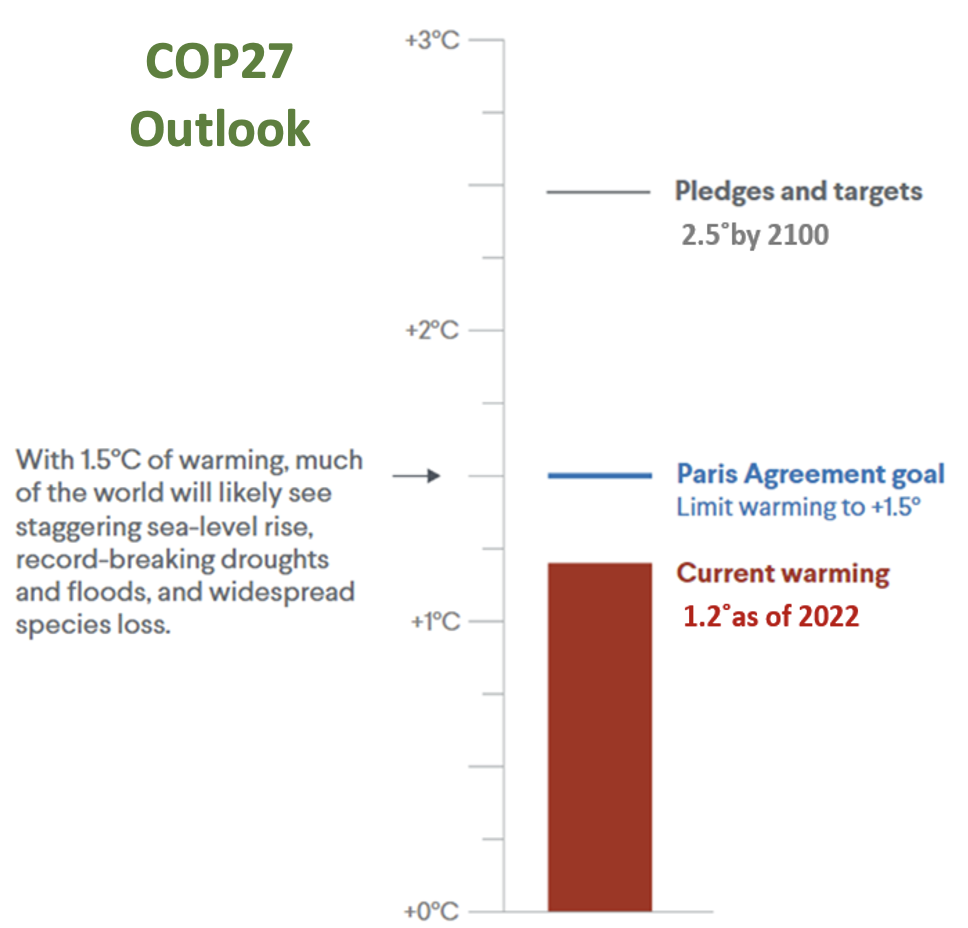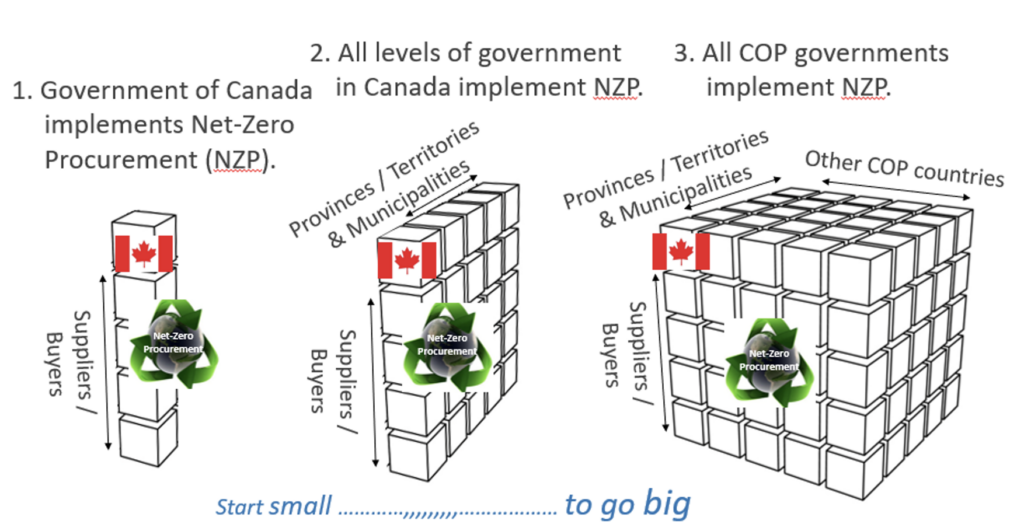Climate Crisis Solutions for the Canadian Government
Lifetime Achievement Honouree Bob Willard, Founder and Chief Sustainability Champion at Sustainability Advantage, outlines three options open to the GC to mobilize the business community in the race to net-zero. Spoiler: the solution to the climate crisis starts with the Government of Canada implementing Net-Zero Procurement (NZP).
Overview
This solution to the climate crisis starts with the Government of Canada (GC) using Net-Zero Procurement (NZP) to incentivize its suppliers to join the race to net-zero. The GC then packages its NZP system and rolls it out to provinces, territories, municipalities, and other jurisdictions. That way, Net-Zero Procurement becomes a ubiquitous market force that quickly mobilizes a critical mass of the global business community in the race to net-zero. This climate solution will work.
Background Context
The Intergovernmental Panel on Climate Change (IPCC) warns that the average global temperature is already 1.2˚C above pre-industrial levels. We are on track to be at 1.5˚C by 2030 and at 3+˚C by 2100. The IPCC has unequivocally declared that to stay under 1.5˚C, we must reduce greenhouse gas (GHG) emissions 50% by 2030 and 100% (net-zero) by 2050.

Pledges by governments at the Conference of the Parties to the UN Climate Change Convention (COPxx) are insufficient and unfulfilled. Without help from the business community, no government can meet its climate-related pledges.
However, most businesses are sitting on the sidelines waiting for their governments to fix climate change. Only 34% of large companies say they are committed to net-zero, and 93% of them will fail to achieve that target in time.
There are basically three options open to the GC to mobilize the business community in the race to net-zero, with sufficient speed and scale.
How the GC can mobilize businesses in the drive to net-zero
Option 1: Introduce regulations mandating that all businesses disclose their GHG performance, net-zero targets, and their GHG reduction plans.
- The advantage of this option is that it levels the playing field for all companies and sends a strong signal that the GC is serious about meeting its climate pledges.
- The disadvantages of this option are that it would be challenging to enforce; penalties for non-compliance would be problematic; it could raise jurisdictional issues; any new “mandate” could be politically challenging; and there is little downside for poor performance, so just requiring disclosures will not stimulate the required aggressive action by businesses to meet science-based net-zero GHG emission reduction targets.
Option 2: Provide incentives for all businesses to disclose their GHG performance, net-zero targets, and their GHG reduction plans.
- The advantage of this option is that incentive-carrots are more attractive to the business community than regulation-sticks.
- The disadvantages of this option are the expense of incentives/funds for a cash-strapped government; the cost of administering the program and auditing recipient companies’ use of the incentives; uncertainty about whether a critical mass of companies would voluntarily disclose their GHG performance and adopt net-zero targets; and uncertainty about whether companies would really follow through on their pledged GHG reduction plans, in time.
Option 3: Implement Net-Zero Procurement
Net-Zero Procurement (NZP) is defined as obtaining the best value for money when purchasing the most climate-beneficial goods and services from suppliers who are most committed to science-based net-zero targets, in support of the buyer’s strategic net-zero goals. There are three main features of an effective NZP system:
- NZP requests that all suppliers disclose their net-zero scores. Suppliers answer a short, SME-friendly Net-Zero Assessment (NZA) questionnaire about their GHG inventories, their commitment to science-based net-zero targets, and their plans to reach those targets. The questionnaire yields a percentage score. The score becomes part of the supplier’s profile in the supplier database.
- NZP incentivizes supplier commitment to net-zero. NZP bid appraisals heavily weight climate-related attributes of products and suppliers. That is, 10%-30% of the points – enough to matter – are allocated to how well the product meets climate-beneficial specifications and to the supplier’s NZA score on its commitment to net-zero targets.
- NZP contracts with suppliers to meet net-zero targets: Winning suppliers are required to commit to plans to achieve net-zero targets, as part of their contract with the GC.
The advantages of Option 3 are:
- It unleashes an instant, massive market force: A significant number of businesses are directly or indirectly in GC supply chains – the GC purchases about $22 billion of goods and services annually. The government is acting as a customer, not as a regulator. Its buying power is a market force.
- It is fair, transparent, and voluntary: All suppliers, regardless of size or sector, are requested to disclose their net-zero performance. It is voluntary ‒ if suppliers opt not to disclose, they simply score zero and will not earn any of the points allotted to the supplier score on commitment to net-zero.
- It is low cost to suppliers: Suppliers answer a consistent, comparable, scorable, SME-friendly Net-Zero Assessment (NZA) questionnaire, freely provided by the GC, to self-assess their score. The NZA can be a tailored version of the free, open-source Net-Zero Assessment Tool (NZAT).
- It is low cost to the GC: The GC is going to spend the money on the goods and services anyway. There may be a slight premium for acquiring the most climate-friendly, low-carbon products from suppliers who are the most committed to science-based net-zero targets, but that is more than offset by the savings on incentives that would otherwise be necessary to equally engage those businesses in the race to net-zero. The GC can use the free, open-source Net-Zero Procurement (NZP) Toolkit to expedite the integration of core net-zero procurement elements into its current procurement systems.
- The NZA questionnaire can be used as a diagnostic: If most suppliers score low in particular areas, the GC could provide targeted resources to help all businesses in those areas.
- It is bottom-up preparation for a decarbonized economy: Driven by the GC NZP market force, and the use of NZP by other governments (see below), a critical mass of suppliers will voluntarily transition to business models and practices that position them to thrive in a decarbonized, green economy.
The only disadvantage of Option 3 is the possible regret about not deploying this market force sooner.
3-Step Solution to the Rubik’s Cube for the Climate Crisis

Step 1: Use the GC as the proving ground for a NZP Toolkit
The GC has already implemented the GHG disclosure and target-setting Standard for major suppliers. Building on that experience, extend the Standard for major suppliers to include any-size suppliers. Pilot an SME-friendly NZP Toolkit in the GC to ensure NZP is simple to integrate into any government’s current procurement system. Package a bilingual NZP Toolkit to facilitate integration of NZP elements into any current procurement system, anywhere in Canada.
Step 2: Make NZP the new normal for public procurement in Canada
Encourage all provinces, territories, and municipalities to use the NZP Toolkit to integrate NZP elements into their current procurement systems. Encourage all suppliers to use the NZP Toolkit to integrate NZP elements into their current procurement systems by giving them bonus points in the NZA if they use NZP with their suppliers.
Step 3: Make NZP the new normal for procurement everywhere
Develop multi-lingual, tailorable versions of the NZP Toolkit for use by governments and companies anywhere. Include implementation of NZP in the final agreement at the next COP, to commit the 200 countries to integrate NZP elements into current government procurement systems in their countries. They can use the multi-lingual, tailorable NZP Toolkit to do this.
Summary
Follow the money. Package the climate solution to make it easy. Use the invisible hand of public sector procurement buying power as a market force to engage the business community in the race to net-zero. Weight suppliers’ scores on commitment to net-zero targets are enough to matter. Ubiquitous Net-Zero Procurement may be the only climate solution that can be successful, in time.












